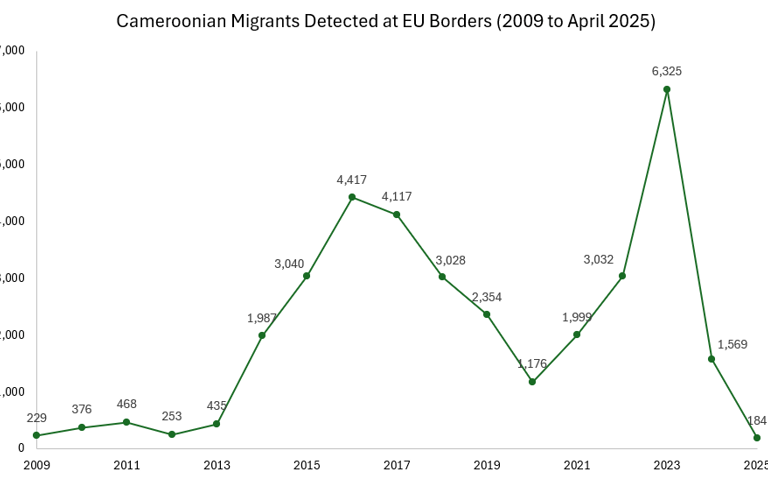Cameroon Crisis: What Migrant Numbers Tell Us
Key Findings
EU Border Agency FRONTEX detections of Cameroonian migrants surged 438 percent between 2020 and 2023, peaking at 6,325 migrants in 2023.
In the first quarter of 2025, FRONTEX detections of Cameroonians have dropped to just 184 migrants.
Much of the ebb and flow of Cameroonian migrants into Europe is mitigated by EU migration accords in Africa that appear to influence migrant trends strongly.
The United Nations High Commissioner for Refugees (UNHCR) records over 169,000 Cameroonians seeking refuge or asylum overseas as of the end of 2024.
Download the full report here, or read online below.
Data source: FRONTEX. Chart by Orunmila.


Cameroon Crisis: What Migrant Numbers Tell Us
The Anglophone crisis in Cameroon has caused many Cameroonians to migrate outwards. The numbers show interesting ebbs and flows over time.
Executive Summary
Since 2017, Cameroon has been in the grip of a crisis. The country has been rocked by the “Anglophone Crisis” (French: La Crise Anglophone), as the English and French language communities' disagreements about linguistic prominence have turned violent. With no end in sight, the pattern in much of Sub-Saharan Africa is that conflict can be a major driver of outward migration. But the statistics show a more nuanced picture.
Cameroon is not just a source of migrants; it also hosts significant numbers of migrants from neighboring countries. The United Nations High Commissioner for Refugees (UNHCR) records 1.5 million refugees in Cameroon, equivalent to 5 percent of Cameroon’s total population. The UNHCR also records over 169,000 Cameroonians seeking refuge or asylum overseas as of the end of 2024 (i). That said, the statistics from the European Union (EU) border agency Frontex are more mixed. Detections surged 438 percent between 2020 and 2023, peaking at 6,325 Cameroonian migrants in 2023. Since then, detections have plunged to just 184 as of April 2025, the latest available data release (ii).
Much of these ebbs and flows dovetail closely with EU externalization strategies in Africa. For example, the decline in 2017 is largely due to the EU Malta Declaration in February that year, which introduced much more proactive shutdowns on migrant smuggling via the central Mediterranean (iii). Numbers fell in response until the pandemic, when a backlog of migrants stranded by border closures recommenced their journeys. The EU deal with Tunisia (mid-2023) and Italy’s offshore processing in Albania (late 2023) appear to have impacted detections significantly, and this is likely to continue given the EU-Egypt migration deal in 2024 (iv, v, vi).
Analysis and Implications
EU Externalization is Making a Mark
The patterns of Cameroonian migrant detections seem to ebb and flow broadly in line with the EU externalization deals with transit countries. The most dramatic fall occurred between 2023 and 2025, with a 97 percent decrease.
Conflict is a Driver, But Not THE Driver of Migration
Despite waves of violence in Cameroon, the relationship between violence and outward migration is not as linear as might be assumed. While Boko Haram violence in northern Cameroon did coincide with outward migration, violence linked to the Anglophone Crisis in the years shortly afterwards did not appear to drive as much, at least not into Europe.
More Cameroonians Are Internally Displaced Than Externally Displaced
While violence from both Boko Haram and the Anglophone Crisis are driving some migration, much of this is internal i.e., migrants moving elsewhere in Cameroon rather than leaving altogether. While the UNCHR estimates that over 169,000 Cameroonians are internationally displaced, the figure internally displaced is 1.5 million, nearly nine-times higher.
Orunmila Research is a consultancy specializing in migration analysis, international affairs, and geopolitical risk. We provide independent, evidence-based, data-driven analysis at the intersection of migration, conflict, and policy. We help governments, NGOs, and institutions understand the deeper, complex drivers behind border movements and instability to allow for a more informed and impactful debate.
Insights
Specializing in migration research.
info@orunmilaresearch.com
© 2025. All rights reserved.
We use AI-generated images for illustration purposes only. To protect the privacy and dignity of migrants, and to comply with local laws in places we operate and research, no photos of real individuals are used. All research and analysis is 100% human-generated.
